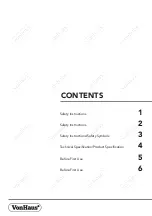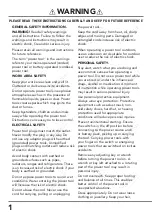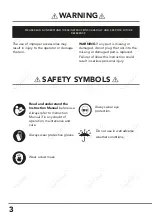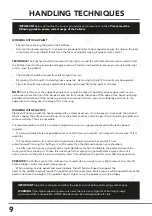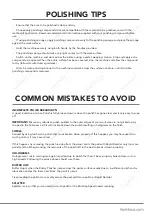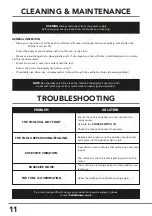
HANDLING TECHNIQUES
WORKING WITH CAR PAINT
•
Spend time centering the pad on the Pad Base.
•
Spin it at the lowest setting (1) to ensure it is properly centred. Higher speeds can give the illusion the pad
is centred as the centrifugal forces force the foam out slightly making it appear more central.
TECHNIQUE
The Polisher should be moved with the right arm and the left hand should only be used to hold
the Polisher head to the paintwork and apply pressure. Practice one handed to ensure you are using the right
arm to move the polisher.
•
The Polisher should be moved from left to right in an arc.
•
By moving it to the right it naturally moves upwards. By moving to the left it naturally arcs downwards.
•
Your arm should move slowly and smoothly keeping the pad flat to the paint at all times.
NOTE
Paint is thinner at the edges of panels so care must be taken. If polishing across edges (such as on a
car bonnet where the line of the bonnet meets the front wings) then tape off the edge of the panel not being
polished. Alternatively lift the bonnet up and have someone hold it so you can confidently polish up to the
edge without running over the edge of the front wing.
WORKING WITH PLASTICS
Plastics will not cope with the heat produced like a metal panel can. It can be easy to ‘over cook’ the painted
plastic causing the surface to wrinkle up. Once the plastic reaches a certain heat it It will wrinkle up rapidly and
without warning. This is irrecoverable.
It is recommended to test this on a plastic scrap pane so you can gauge the amount of Rotation Speed
required.
•
On curved panels this is not possible so more of the focus is on smooth, non jerky arm movements. This is
essential.
•
It is recommended to try and stand with your back straight ensuring that you don’t over
extend yourself, moving the ‘buffing arc’ a little wider than the distance between your shoulders.
•
It is often useful to spray a dry pad with a rapid detailer spray first to lubricate the pad and prevent too
much polish from soaking in. To take this one stage further spray a dry pad with detail spray and work it
onto a panel until the pad is warm and slightly moist. This will season the pad for more effective application.
PRESSURE
The Polisher can for the most part work under its own weight or very light pressure from the left
hand. Stubborn swirls may need more pressure.
•
When working on side panels and curved panels, the left hand will need to support the
head of the polisher and will require the application of more pressure. More pressure will be needed here as the
pad will not have the weight of the polisher over it. Again, move the polisher in arc like strokes.
IMPORTANT
Below will outline the correct procedures and precautions to take.
Please read the
following guide to ensure correct usage of the Polisher.
IMPORTANT
Stop after each pass and allow the plastic to cool before attempting another pass.
WARNING
If too higher speed or pressure is used, there is a very high risk of burning through
paintwork which is irreparable. DOMU Brands cannot be held responsible for this.
9


